|
Have
you ever driven down Broad Street in Henrico County?
It's an elongated stretch of suburban wasteland that
snakes through the western part of the county, one gas
station, one chain restaurant, one auto dealership, one shopping
center and one big-box store after another. For miles and
miles and miles.
No
matter how much you may loathe Broad Street, you can't
avoid it -- not if you live north of the James River in the
Richmond region. Not even if you reside in an an urban neighborhood like the Fan or
Church Hill. Unless you have foresworn all material
goods and moved to a monastery, sooner or later,
you'll need to patronize a store that can be found on
Broad Street and only on Broad Street.
The
first thing I hate about Broad Street is how hard it is
to find your way around. There's no lack of signage, but I'd
rather take my chances of tracking down Ahmed's Camel
Emporium in the Medieval streets of Marrakesh than
locating an auto parts store on Broad. The problem
is that Broad Street has so many signs, each bigger and
brighter and more neon-lit than the other, that they
overwhelm the senses. When you're driving down a
three-lane boulevard at 40 miles per hour, keeping an
eye on traffic and throwing quick glances over your
shoulder, you have a better chance of solving a Where's
Waldo puzzle on the run than spotting the store sign
you're looking for.
It
would help if shops and restaurants actually posted
their addresses on the premises, so you could decipher
if you're at least within a 10-block radius of the
location. But most establishments don't bother. Of those
that do, many are recessed behind acres of parking lot, front buildings or
useless clumps of vegetation referred to as "landscaping."
Either that, or the numbers
are so small that you can't read them without squinting
so long you run the risk of side-swiping the car in the
lane next to you.
The
other thing I hate about Broad Street is that if you're
starting at Point A and want to get to Point B, you
can't get there from here... Even if you know where
Point B is.
The
other day, I drove to Circuit City to buy a back-up
storage device for my computer. After drooling over the
new, 60-inch, high-definition Sony television that I'll
never be able to afford, I figured I'd stop by
Borders Books nearby. How
hard could that be? Borders was only a block or two away, as
the crow flies.
Hopping
into the Mighty Usuthu, my trusty Jeep Cherokee, I wheeled onto the
driveway leading out of the shopping center. It looked easy
enough. All I had to do was wait for a break in the
traffic and turn left.

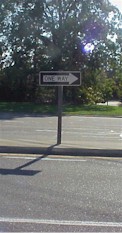 Wrong. Wrong.
Obscured
by the traffic, there was a low, concrete dividing strip
separating the east-bound from the west-bound lanes. A
"One Way" sign made it clear that turning left
was not an option.
So,
right turn it was. Pulling onto Broad Street, my goal
then was to dash across three lanes of traffic within a
space of 50 yards in order to grab a space in the
inside left-turning late (below). To land in the outside
left-turning lane was a fate to be avoided at all costs:
The traffic flow would sweep me onto Gaskins Road and halfway
to Interstate 64 before I could find a spot to turn
around.

Having
suffered precisely that mishap once before, I maneuvered
Usuthu aggressively to the inside lane. When the light
changed, I smartly executed a U-Turn to head back east.
I
drove a long block to the next intersection and espied
the Borders Books sign ahead on the left. I had two
choices. I could proceed down Broad to the next
intersection, execute another U and then look for the
entrance into the Borders parking lot. That seemed
unnecessarily complicated. It made more sense just to
turn left right here and find the back entrance.
Committed
to this course of action, I turned left... and promptly
got stuck in traffic. A red car ahead of me (below),
determined to turn left into a gas station, blocked the
cars behind it, leaving me stranded in the intersection.
The red car was obstructed by a line of cars waiting
for the light to change, none of them seeming willing to
budge.

Eventually,
the situation resolved itself before I became the
problem, blocking
the oncoming traffic from Broad Street and triggering the
car rage of some Yuppie in a hurry and a bad mood. As the congestion cleared, I nosed Usuthu down
this side street in search of a cut-through to the
Borders parking lot.
Uh,
oh. It looked like the cut-through from Borders was one
way! I'd miscalculated.

I drove past
the intersection, wondering what to do when I realized
that the "one way" cut-through was,
in fact, the entrance to a bank, and that the Border's
cut-through was immediately past it. Due to the presence
of cars blocking the view, I just hadn't seen it. But by that point,
it was too late to turn. I braked, hoping to turn left
instead and then find a place to turn around. Cars
were piling up behind me. Too bad. They'd have to wait.
I didn't dare keep going straight -- who knows where I
would have ended up?
I
imagined myself on the Six O'clock News: A
52-year-old Henrico County man was found wandering dazed
and disoriented north of Broad Street earlier today.
Showing signs of dehydration and stress, he'd apparently
abandoned his car when it ran out of gas. Rescue
squadsman Fred Finglemeier stated that the man, still
unidentified, kept muttering the cryptic phrase, "Must find borders...
Must find borders."
At
last, a
break in the traffic allowed me to turn left -- onto the street leading to Borders, but in 180 degrees
in the wrong direction. That's OK. I was getting close.
I could feel victory within my grasp.
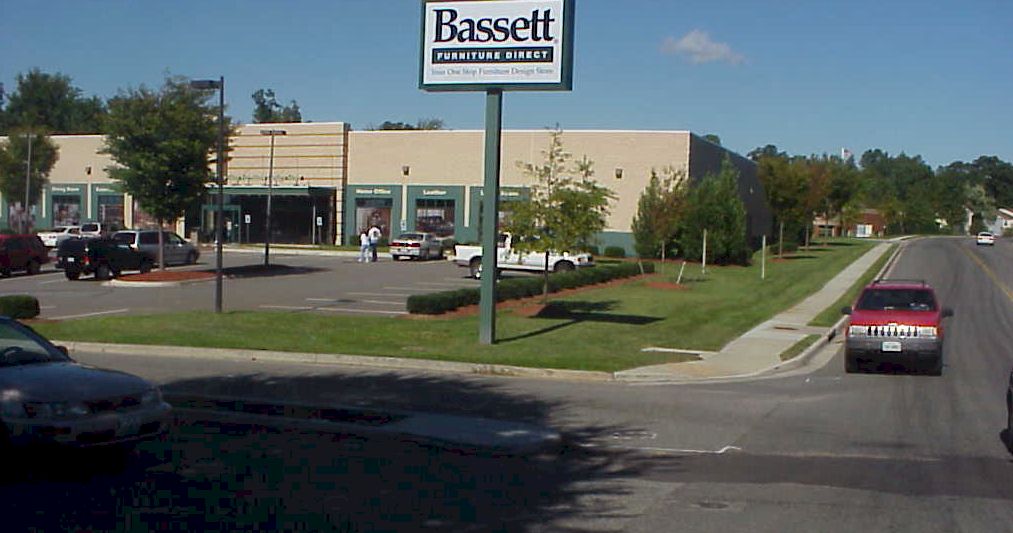
OK.
All I needed to do now was turn around. Of course, that
was easier said than done. The utility road was too
narrow. So, I pulled Usuthu into the first parking lot
available: the Bassett Furniture lot (cut-through shown
below).
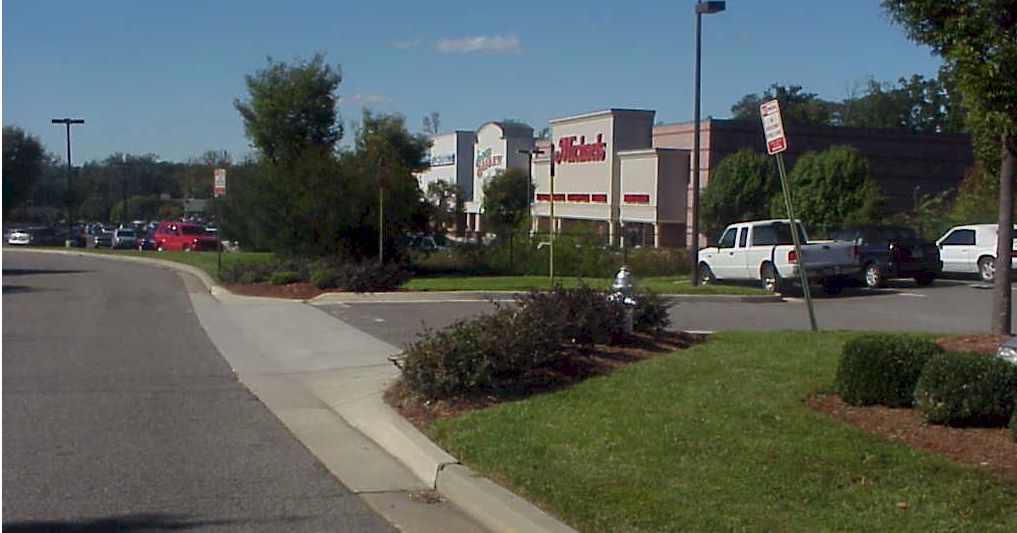
I
managed to execute that maneuver without incident. The
next task was to turn around in the Bassett parking lot
and come back out. That task, too, was easily
accomplished. I simply wheeled around a cluster of
parking spaces (below) and went out the way I came in.

Mirabile
dictu! I was now heading in the right direction, and the
Border's Books building loomed straight ahead.
I
worked my way through the curiously congested little
intersection and pulled into the utility road behind
Border's. I was getting close now!

But
I wasn't there yet. There were plenty of random parking
spaces, but there was no entrance to Border's on this
side of the building -- unless you counted the loading
dock (below).
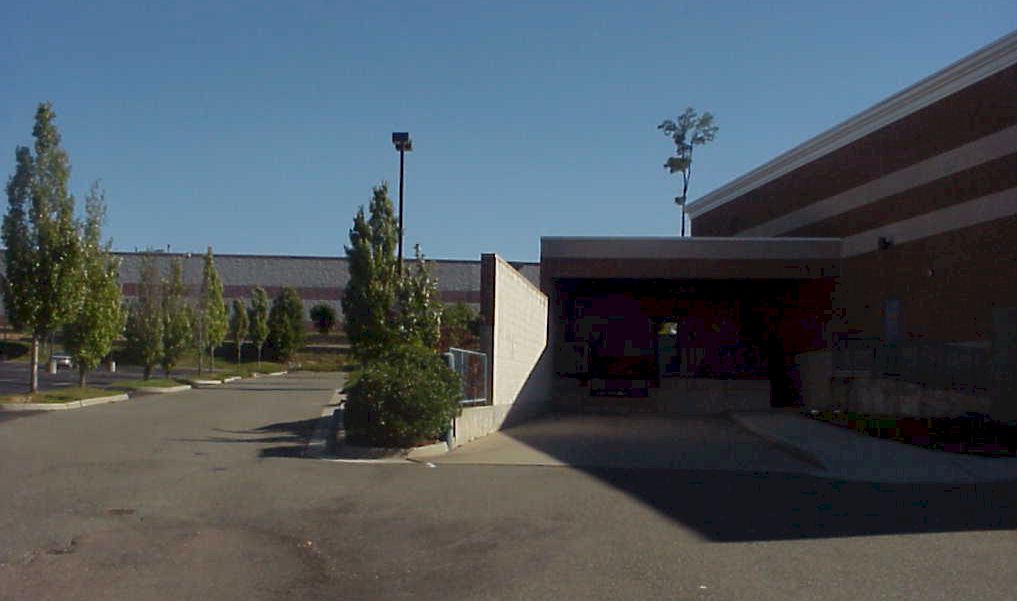
True
story: As I was taking the photograph above, an elderly
gentleman and his wife stopped their car and asked me
for directions! Me! The pitiful fools were asking
me! They were looking for "a tile place
near Costco," they said, and hadn't been able to find it. They
had been driving around, quite lost. Sadly, I told them
I could be of no help. I had no idea where anything was
located...
...
except for Borders. And I knew where it was because I
literally could see it, even if I could not yet find a
way inside. My
pulse quickened. I was in the home stretch now. Skirting the back of the Border's
building, I finally came upon my destination: The front
entrance of Border's, with row upon row of parking
spaces. Yesss! High fives all around!
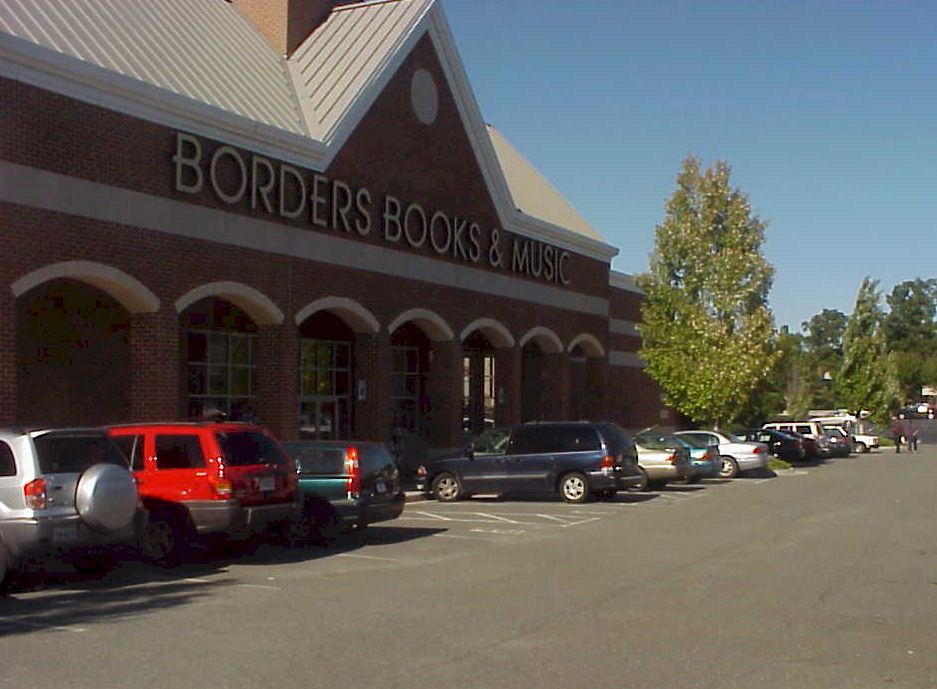
There
is a lesson to this story. My wife would tell you the
lesson is that I am navigationally challenged. I don't
dispute that. But there is a larger lesson. Our suburban
roads
are designed with one goal in mind -- to move cars --
which they do with great efficiency if your measure of
achievement is maximizing the throughput of cars along
thoroughfares like Broad Street.... but not if your measure is getting
logically from Point A to Point B.
Everything
in suburbia is disconnected. Retail establishments are
jammed in coagulated clumps, accessible only by
automobile. The clumps aren't integrated with the
residential communities around them, nor even integrated
with each other. All stores are located in their own
little pods, surrounded by husk-like parking lots, berms
or landscape barriers. And, like their residential cul
de sac counterparts, they empty onto a main
thoroughfare, through which every car must travel in
order to get anywhere else. There is no underlying
logic to the where things are located and there are few
visual cues on how to get
from one place to another.
Henrico
County traffic engineers might well congratulate
themselves on all the cars they can pump through Broad
Street. But how much of that traffic consists of people driving in the direction opposite of the way they
want to go? How much of it consists of people making U turns and
back-tracking to get somewhere because the median strip
had blocked them from turning? How much of it consists
of people
wandering up and down the strip, fuming and cursing
because they can't find the location of a wretched tile
shop?
Getting
lost in suburbia is not a phenomenon unique to Henrico
County. It's scary to contemplate, but Henrico is
actually one of the better designed localities in Virginia!
I've seen worse horrors on Chesterfield's Midlothian Turnpike,
Norfolk's
Military Highway, Charlottesville's U.S. 29, and
Fairfax's
Route 7. The disorder can be traced to zoning codes
and comprehensive plans that jam retail establishments into densely
packed corridors and set rules for cut-throughs. But for
all the rules that are required, local governments
overlook one thing: connectivity.
Local
governments tell property owners what kind of businesses
can be located in a commercial zone, how much square
footage they may build, how far back from the road the
buildings must sit, and how many parking spaces they
must have. But no one tells developers to build an
alleyway or utility road that would link a string of
stores together so shoppers can navigate from one to the
next without going back onto the main street. How crazy
is that?
Some
of Virginia's legislators and business leaders insist
that Virginia faces a "transportation" crisis,
and that the state needs to raise tolls and taxes to the
tune of $5.4 billion a year over the next 20 years or
descend into statewide gridlock. What Virginia really
has is a "design" crisis. We separate
land uses -- homes, offices, shopping -- from one
another spatially. Then we spread them out so that
everyone must use a car to get anywhere. And then we
devise a set of regulations that unplugs
everything from everything else.
I
suppose that raising taxes and building more roads is
one way of dealing with the problem. But I'm one of
those people who prefer to keep my money rather than
give it to the government unless I know there is no
alternative. In this case, there is an
alternative: Better zoning and better design.
The
art of building better communities is getting the nitty
gritty details right. Unfortunately, the details don't
make good sound bites for politicians. "Improved
Cut-Throughs for all Virginians. Vote for Delegate
Crank!" is not likely to inspire many voters.
Even
so, cut-throughs and navigability are something we need to
get right, and we have no business raising taxes until
we at least try.
--
October 17, 2005
|
